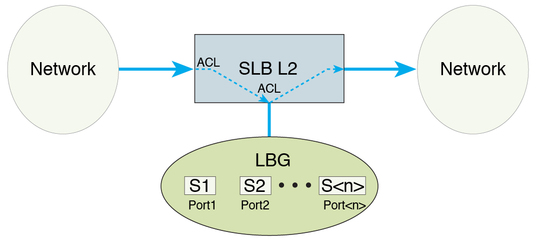| Skip Navigation Links | |
| Exit Print View | |

|
Sun Ethernet Fabric Operating System SLB Administration Guide |
Configuring the SLB Topology Example
SLB Configuration Guidelines and Prerequisites
Configuring the SLB-L2 Topology Example
SLB-L2 Configuration Guidelines and Prerequisites
Conditions for a Member Participating in Load Distribution
Set the Traffic Distribution Policy
Restore the Default Traffic Distribution Policy
View the Traffic Distribution Policy
Restore the Default Traffic Distribution Policy
Restore the Default Failover Method
Creating Example SLB Configurations
Creating a Basic SLB Configuration
Save the Current Configuration
Creating a Separate VLAN SLB Configuration
Separate VLAN SLB Configuration
Configuration With Separate VLANs Steps
Save the Current Configuration
Creating a Multiple SLB Group Configuration
Multiple-SLB-Group Configuration
Configuration With Multiple SLB Groups Steps
Set Up the Servers in SLB Group 1
Set Up the Servers in SLB Group 2
Save the Current Configuration
Restart the Server Following Failure
Creating SLB-L2 Configuration Examples
Bump-In-The-Wire Configuration
Creating a Single-Switch Configuration
Basic Single-Switch Configuration
Create a Single-Switch Configuration
Creating a Dual-Switch Configuration
Create a Dual-Switch Configuration
This figure shows the SLB-L2 topology used in this document.

In SLB-L2, all traffic operates within the same subnet, which means that no routing takes place in the load distribution data path. Traffic that needs to be load balanced will first be filtered out by ACL at the ingress port. If data is permitted by the port, ACL redirects the traffic to an LBG. Traffic leaving the switch ports within an LBG can be tagged with a unique VLAN ID before reaching the servers connected to the ports. After the servers process the data, all traffic that enters the switch with the tagged VLAN ID is redirected to an egress port of the switch.
You can configure ingress and egress ports as the same or as different ports, referred to as a bump-in-the-wire configuration, where the servers are the "bumps" in the wire for packet processing. SLB-L2 divides ingress traffic into multiple flows and hashes them into multiple server members. This mechanism enables simultaneous processing of multiple data flows, increasing the overall throughput of the wire.